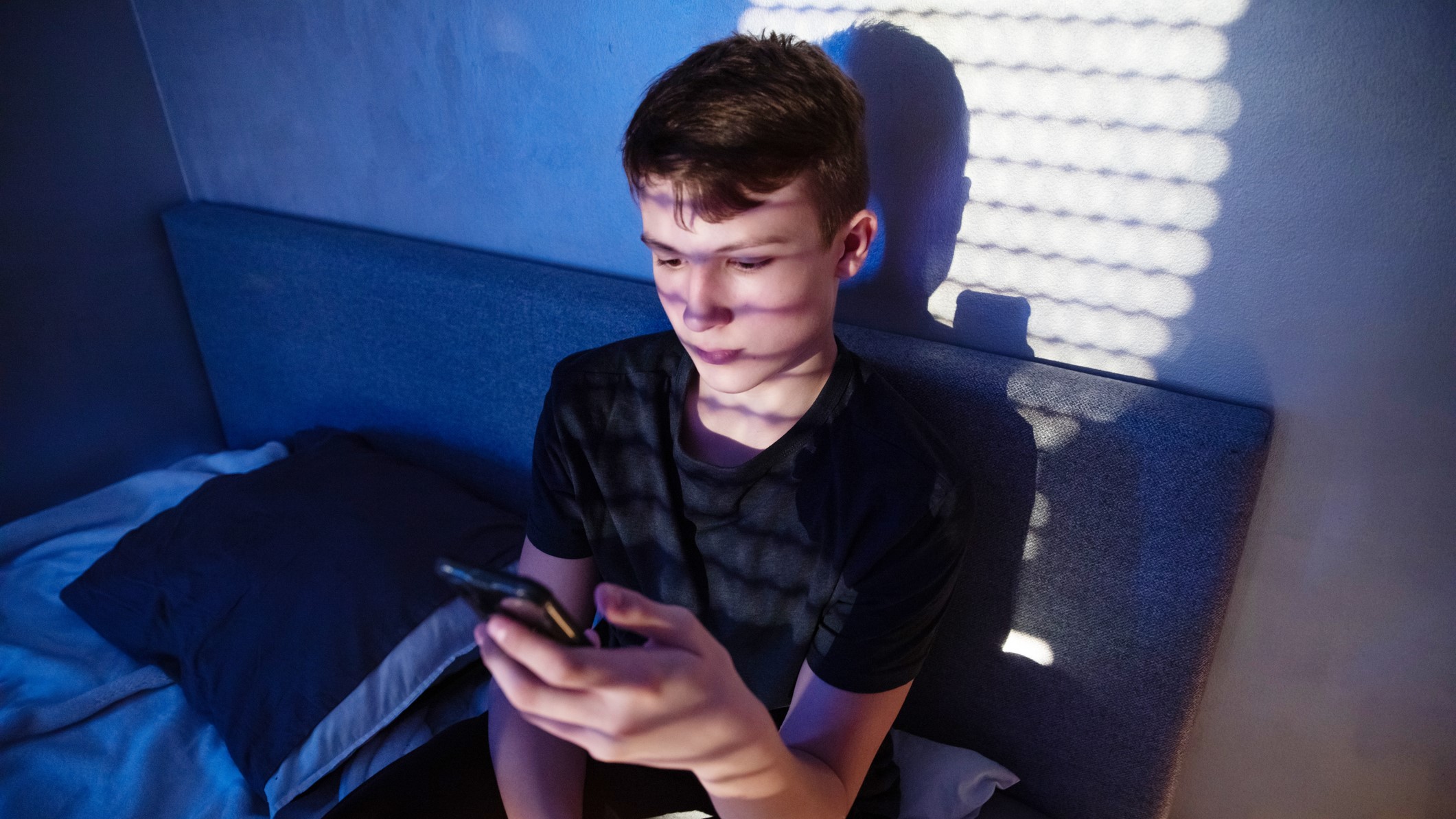What is cyberbullying? 11 things parents need to know about
Find out exactly what cyberbullying is and whether your child is at risk, plus how to spot the signs and report it
Sibelle Mehmet

As our children navigate the digital world, they face a threat that many of us never encountered in our youth: cyberbullying.
This online form of harassment uses technology to intimidate, humiliate, or harm others, taking many shapes - from cruel comments and trolling to exclusion from online groups and sharing embarrassing images.
According to Ofcom’s latest research into children’s media and online habits, four in 10 children aged 8-17 have experienced bullying, either on or offline. And worrying, 84% of those bullied said it happened on a device rather than face-to-face.
Learning about cyberbullying can feel overwhelming as a parent, but you're not alone in worrying about how social media can affect your child's mental health. Ofcom says as much as two-thirds of parents are worried about their child being bullied online. In this article, we'll explore how to recognise the signs of cyberbullying, steps to prevent it, and effective ways to keep your children safe online. Drawing on expert advice, we'll arm you with the knowledge and tools to confidently guide your kids through their digital experiences, helping them to build coping skills that can help them stay resilient and safe online, as well as in the real world.
What is cyberbullying?
Cyberbullying can take many forms. We spoke to Yaron Litwin, CMO of parental control app Canopy, to find out more. gives us some examples: Examples include trolling, where someone posts cruel comments to provoke others; doxing, where personal information is shared publicly; and excluding, where individuals are deliberately left out of online groups or activities. On the extreme end of the cyberbullying scale, it can also include sextortion - blackmailing a child with explicit pictures or videos that the bully has in whatever way acquired. While it might be heartbreaking to think your child might experience any of these, it’s important to stay informed of what’s possible, and what you can do to prevent it from happening.
One of the biggest differences between cyberbullying and traditional bullying is how hard it can be to escape from it. Yaron points out that cyberbullying "can happen at any time and place, making it easy to carry out and almost impossible to avoid."
"It's just really mean," says Harry, 11. "It's bad for kids, and it can really affect their mental health. My friend was cyberbullied by his own friends during the holidays. Every day, he would wake up to them roasting him through messages, and it really upset him."
Parenting advice, hot topics, best buys and family finance tips delivered straight to your inbox.

Psychotherapist Kristie Tse also explains why cyberbullying can feel so intense for our kids: "Unlike in-person bullying, where bullies usually confront their targets directly, cyberbullying allows for a level of cruelty that can be pervasive and relentless, extending beyond the school playground or classroom into homes." This means kids might not ever feel safe - even in their own bedrooms.
Kristie shared her experience of treating kids with mental health problems as a result of cyberbullying: "I've witnessed the significant mental health impacts it can have, often leading to anxiety, depression, and diminished self-worth."
Remember, while cyberbullying is a serious issue, there are many effective strategies and tools available to help protect your child and address any problems that arise. We’re about to show you how.
Examples of cyberbullying
Cyberbullying can take many forms, and it's possible our list won't cover every type or that the cyberbullying will use one or more of these types. Here's what we know so far from our experts and anti-bullying organisations:
- Harassment: Repeatedly sending offensive, threatening, or abusive messages to a person through digital platforms.
- Impersonation (Catfishing): Pretending to be someone else online to deceive, embarrass, or harm another person.
- Exclusion: Intentionally excluding someone from online groups, games, chats, or social circles to isolate them socially. This can also include voting for or against someone in an online poll.
- Outing/Doxing: Sharing someone’s private or personal information, images, or secrets online without their consent.
- Cyberstalking: Persistently monitoring, following, or sending threatening messages to someone online, causing them to feel fear or distress.
- Trolling: Posting menacing, offensive, or upsetting comments online to upset or provoke a reaction from others.
- Denigration: Spreading false, harmful, or malicious rumours or statements about someone online to damage their reputation. Can also include setting up hate sites or groups about a particular child.
- Fraping: Logging into someone’s social media account without permission and posting inappropriate or embarrassing content.
- Flaming: Engaging in aggressive and hostile verbal exchanges online, often in public forums or comment sections.
- Sexting: Sharing or threatening to share explicit images or messages without consent, often as a form of coercion or blackmail.
- Sextortion: Pressuring victims into sending sexual images or pretending that you have images that will embarrass them in order to blackmail or coerce them.
Comments, memes or posts that start out as jokes can quickly become harmful, too, as 15-year-old Nathan found when he shared offensive content about people with learning disabilities because he thought it was funny. “It's a controversial joke... I think I saw it and reposted it from somewhere. They (my mates) know it's a joke, so they wouldn't take offence.”

How to spot the signs of cyberbullying
There's no one particular sign that your child is being cyberbullied, but there are certain behaviours you should watch out for:
- Showing signs of stress, such as being moody, silent or crying, especially after using their phone, being online, or gaming.
- Making excuses to miss school or other events with friends or classmates.
- Being secretive about their phone or computer use.
- Being withdrawn.
- Spending more time in their room.
- Suddenly wanting to spend less time on their phone, computer or games console.
- Changing their eating habits.
- Seeming nervous or jumpy when their phone pings.
- Avoiding discussions about social media or other online activities.
- Sleeping badly.
How to report cyberbullying
The National Bullying Helpline offers the following advice on reporting cyberbullying and online harassment:
- Document any online bullying by taking screenshots, keeping emails, and other evidence. Print off copies if you can.
- Report any harassment or bullying to the platform where it occurs. Look for 'report' or 'red flag' buttons or use built-in reporting tools.
- The website Report Harmful Content has more help and advice on how to report bullying.
- Involve your child's school if it is another pupil.
- Block bullies on social media, messaging apps and gaming platforms.
Freya, 12, has valuable advice for kids experiencing cyberbullying. "Just ignore it when it happens, but bring it up with someone later, like a parent or maybe a teacher, if it's a classmate doing it."
Is cyberbullying a crime?
We also spoke to solicitor Samantha Hale of HCB Solicitors to gain a legal perspective on bullying and cyberbullying and where the law currently stands. She told us, “Bullying itself is not a specific criminal offence, However, bullying can sometimes be so severe that it can actually constitute a criminal offence if there is a threat of violence or actual violence; assault; theft; criminal damage or repeated harassment or intimidation, for example abusive text messages, emails, social media posts (cyberbullying), phone calls or direct name calling, or hate crimes. Bullying of this nature should be reported to your child's school and the police, without delay."
How to prevent cyberbullying
- Teach your child to only add trusted friends and family to social network sites and tell them not to lend their phone to other people or give out their phone number on internet chat rooms.
- Remind them that pictures on phones can be traced and forwarded - they should be careful what picture messages they send and who they send them too.
- If your child receives a video or a photo of someone else being hurt they need to know that it's okay to tell you. They shouldn't feel like they're being a 'snitch'.
- Make sure your child is cautious if they have Bluetooth or Airdrop on their phone and tell them not to accept messages or images from people they don't know.
- Make sure your kids have the confidence to reject calls from people they don't know.
- Get them to adjust the privacy settings covering their online profiles.
Sites and apps parents should be aware of
While apps and website do not intentionally pose a threat to children and teens, if used incorrectly they can provide an opportunity for children to make bad decisions and engage in potentially dangerous behaviour.
- AskFM - AskFM is a social platform where users can anonymously ask other users questions. Some children have used this app to cyberbully other children by sending hateful messages.
- Qooh.Me - Similar to AskFM, Qooh.Me enables users to anonymously ask questions to one another.
- KiK - KiK allows users to anonymously to chat to each other. The app is for 17 year-olds but there is no age verification so anyone is able to access the messaging service.
- Snapchat - Snapchat is a social platform allowing users to send videos and photos to each other. After a certain time the video or photo disappears. However, users are able to screenshot the image before it disappears. This app is sometimes used to send inappropriate photos.
- Tumblr - Tumblr is a platform allowing users to share posts and images with other users. Tumblr allows inappropriate content such as porn, pro-anorexia posts, and pro self-harm posts.
- Calculator+ - Disguised as a calculator this app allows kids and teens to hide contacts, photos and browser history behind a password.
- Omegle - Omegle is a web browser which connect users to a total stranger via a chat or video room.
- Voxer - The Voxer app allows individuals to exchange voice messages. Hateful messages from cyberbullies can be more threatening when spoken aloud.
Take a look at our guide on how to keep kids safe online and learn more about the dangers of social media sites such as Facebook and Instagram. If you are worried about your child, our guide on how to talk to your children about mental health can help.
Featured experts

Yaron Litwin is an online safety expert and CMO of Canopy Parental Control App, an AI-powered solution that filters and monitors harmful and explicit content in real-time.

Kristie is a psychotherapist with years of experience in mental health, particularly in navigating complex social dynamics. With a focus on culturally sensitive, evidence-based therapy, she is dedicated to addressing issues such as cyberbullying and its profound impact on individuals, especially within marginalised communities.

Samantha is a Director and Solicitor at HCB Solicitors, in one of the largest specialist education law teams in England and Wales. Samantha has worked in education law for over 15 years. She assists with a wide range of education law issues, with a large focus on special educational needs law representing children, young people and their families.
Samantha’s previous work includes working for a Local Authority and the Department for Education.
Joanne Lewsley is mum to a tween, and freelance copywriter and editor who creates parenting, health and lifestyle content for evidence-based websites, including BabyCentre, Live Science, Medical News Today and more.
- Sibelle MehmetJunior Digital Writer